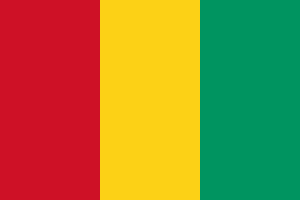Flag of Guinea facts for kids
The national Flag of Guinea is a very important symbol for the country. It was first created and used on November 10, 1958. This flag has three vertical stripes, which is why it's called a tricolour. The colors are red, yellow, and green.
Contents
The Flag of Guinea: What the Colors Mean
Each color on Guinea's flag has a special meaning. These meanings tell us about the country's history and its hopes for the future.
- Red stands for the hard work and sacrifices made by the people of Guinea. It also represents the blood shed by those who fought for the country's freedom. Red reminds everyone of the strength and determination of the Guinean people.
- Yellow represents the bright sun and the rich natural resources of Guinea, especially its gold. It also symbolizes justice and the idea that everyone should be treated fairly. Yellow brings to mind the wealth and prosperity that the country aims for.
- Green stands for Guinea's beautiful nature, including its lush forests and fertile land. It also represents the hope for a good future and the country's strong connection to farming. Green shows the importance of agriculture and the promise of growth.
These three colors together also represent the national motto of Guinea: "Work, Justice, Solidarity."
How the Flag Was Created
The Flag of Guinea was designed and adopted in 1958. This was a very important year for Guinea because it gained its independence from France. The new flag was a way for the country to show its new freedom and national identity.
The design of the flag was inspired by the flags of other African nations, especially those that were part of the Pan-African movement. This movement aimed to unite and empower people of African descent. The colors red, yellow, and green are often called "Pan-African colors" because they are used on many flags across the continent.
Guinea's Journey to Independence
Before 1958, Guinea was a colony of France. This meant that France controlled Guinea's government and resources. However, many Guineans wanted to rule themselves and make their own decisions.
In 1958, Guinea held a special vote to decide its future. Unlike many other French colonies that chose to stay connected to France, Guinea voted for complete independence. This was a brave and historic decision led by figures like Ahmed Sékou Touré, who became Guinea's first president. The creation of the new flag was a big part of celebrating this new freedom and showing the world that Guinea was now an independent nation.
Images for kids
See also
 In Spanish: Bandera de Guinea para niños
In Spanish: Bandera de Guinea para niños




